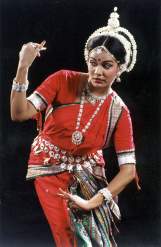
Odissi
Indický tradiční tanec
Tanec Odissi
Podle indické mytologie vynalezli tanec bůh Šiva s bohyní Párvatí. V různých
oblastech však má různé podoby a názvy. Ty jsou závislé na podnebí, prostředí
a jazyku, a představují širokou škálu forem lidových, kmenových a klasických.
Indický klasický tanec se vyvíjel jako výraz duchovního odevzdání se vyššímu
bytí. Odissi je ze všech klasických tanců nejpoetičtější a je plný půvabu
a elegance. Vznikal ve slavných chrámech v Puri, Konáraku a Bhuvanéšvaru.
K těmto chrámům příslušel velký počet mladých tanečnic, pocházejících z kasty
Mahari. Měly za úkol zajišťovat ranní a večerní rituály. Tato tradice přecházela
z generace na generaci.
Z archeologických poznatků vyplývá, že Odissi může být považován za nejstarší
formu klasického tance v Indii. Také Natjašástra, nejstarší autentický text
o indickém tanci a dramatickém umění, zmiňuje jeho existenci.
Základem tance Odissi jako ideální taneční formy je způsob, jakým se využívají
pozice napodobující sochy. Většina z těchto krásných výjevů je velmi blízká
sochám na slavných chrámech, kde se pěstovalo umění. V Uríse byly tanec
i sochařství, týkající se hinduistické ikonografie, bohatě využívány. Pro tanec
Odissi je charakteristický také odklon od melancholie, pózy se třemi ohyby těla
(Tribhanga) a obloukovité kresby rukou při současném kroužení tělem. Tato
taneční forma má jemný smyslný šarm. Když zaplní tanečnice prostor
se symetrickými prvky obdélníků, čtverců a kruhů, naskytne se fascinující
podívaná.
Program
Mangalačaran: Představení Odissi obvykle začíná expresívním tancem
Mangalačaran, kterým jsou velebeni bohové Džagannáth, Ganapati nebo Ádišakti.
Batunrita: Tento čistě taneční výstup vzdává poctu bohu jménem Batuka
Bhairava, který je jedním z převtělení boha Šivy. Vyznačuje se sošnými pózami.
V některých pasážích tance Batu Nrtja přijdou ke slovu také tajuplné rytmické
prvky.
Pállaví: Pállaví je další čistě taneční forma, v níž mají všechny pohyby
lyrický půvab. Základem pro tento tanec je jemná a veselá melodická rága.
Nádherné taneční pasáže jsou prováděny souběžně se zpívanými rytmickými
slabikami.
Abhinaja: Abhinaja je nejdůležitější částí pětidílného repertoáru Odissi.
Je čtvrtá v pořadí a vychází z částí předešlých. V Pállaví se předvádí taneční
technika s pohyby celého těla a obdivuhodnou prací nohou. Tanečnice buduje
spletitou dramatickou stavbu, uplatňuje důmyslnou gestikulaci rukou, zvanou
mudry. Tuto část uzavírá zpěv a hudba.
Mókšja nrutja: Indická filosofie učí, že veškerá lidská aktivita má vést
ke spáse. "Mókša" znamená doslova "spása". Extatický tanec, který umožňuje
tanečníkům přiblížit se k tomuto cíli, se nazývá Mókša Nata. Tímto rychlým
tancem s rytmickými krokovými variacemi program končí.
Odissi
Indian traditional dance
Odissi dance
Dance is believed to have originated mythologically in a single form by Lord
Shiva and Devi Parvati. But subsequently it took on varied forms and names in
different areas depending on climate, environment and language, giving rice to
different folk, tribal and classical dance forms.
Classical dance in India evolved as a spiritual expression of devotion to the
Higher being. Odissi, the most graceful and lyrical of all the classical dances,
was, therefore nurtured in the famous shrines of Orissa situated at Puri, Konarak
and Bhubaneswar. A large number of dancing girls, originating from cast Mahari, were
attached to these famous shrines to form the morning and evening rituals of the
Deities. Its tradition was thus maintained through generations of these devoted
temple dancers.
On the basis of archeological evidence, Odissi may well claim to be the earliest
classical dance style of India. Natyashastra, the most ancient and authentic
text on Indian dance and dramatics, also acknowledges its existence.
The quintessence of Odissi, as an ideal dance form, is in its sculpturesque
quality. Most of its beautiful poses bear close resemblance with the sculptures
of the famous temples which once nourished the art. In Orissa, both in dance as
well as in sculpture, the Bhanga (bend) concept of Hindu iconography have been
fully exploited. The characteristic features of Odissi are in its deflection of
the hip, poses with three body bends (Tribhanga) and archwise designs of hand
movements with rounded liquid body movements. This dance form has a sensuous
charm. While covering the space the dancers with symmetrical patterns of
rectangles, squares and circles create myriad of fascinating visuals.
Programme
Mangalacharan: A performance of Odissi customarily begins with Mangalacharan, an expressional
piece offering praise to Lord Jagannath, Ganapati or Adishakti.
Batunrita: Batu Nritya is a pure dance offering in honor of Lord Batuka Bhairava, an aspect
of Lord Shiva. This dance item is marked for its sculpturesque poses. Uncanny
rhythmic patterns are also worked out elaborately in different passages of this
dance.
Pallavi: Pallavi is another form of pure dance with movements of lyrical grace. It is
based upon a Raga which is soft, lilting and melodious. Beautiful dance passages
run parallel with rhythmic syllabes sung musically.
Abhinaya: Abhinaya is the very corpus of the five segmented Odissi repertoire. Coming
forth in succession, it deviates from the items before it i. e. the Pallavi is as
much as pure dance technique, body movement, foot work lesson. Histrionics takes
over Aiding & Complementing the dramatics is intricate, erocative hand gestures
known as mudras. The blend is finally set to the song and music.
Mokshya Nrutya: Indian philosophy expounds that all human activity tend toward salvation.
"Mokshya" literally means "Salvation". The pure dance of ecstasy that liberates
the dancer towards this goal is known as Mokshya Nata. This is a fast-paced
rhythmic dance which concludes the programme.
